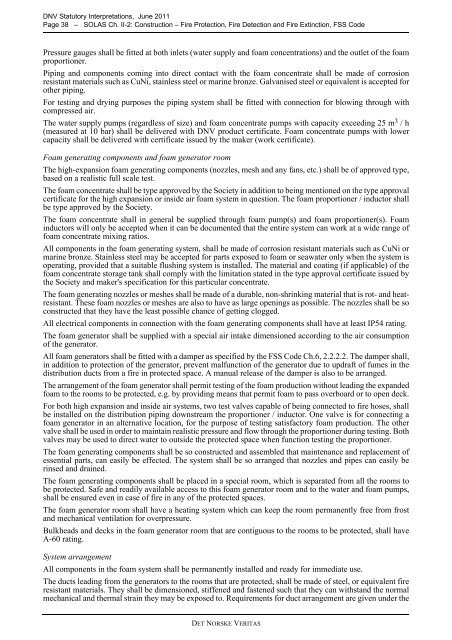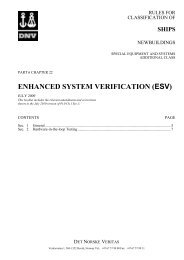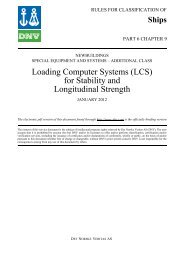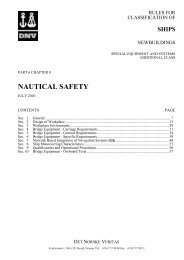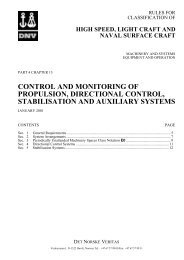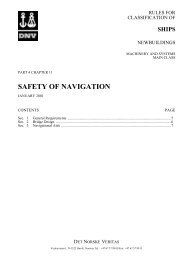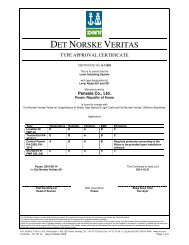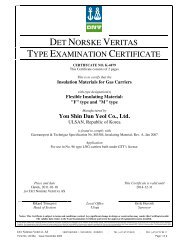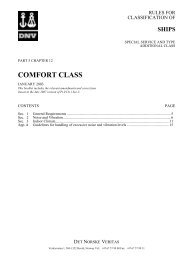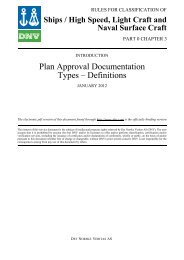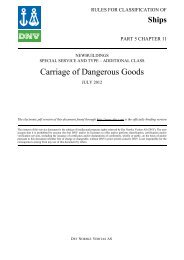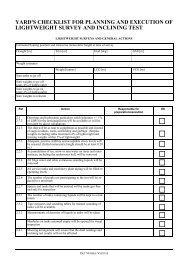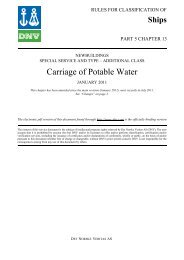solas interpretations - DNV Exchange
solas interpretations - DNV Exchange
solas interpretations - DNV Exchange
Create successful ePaper yourself
Turn your PDF publications into a flip-book with our unique Google optimized e-Paper software.
<strong>DNV</strong> Statutory Interpretations, June 2011<br />
Page 38 – SOLAS Ch. II-2: Construction – Fire Protection, Fire Detection and Fire Extinction, FSS Code<br />
Pressure gauges shall be fitted at both inlets (water supply and foam concentrations) and the outlet of the foam<br />
proportioner.<br />
Piping and components coming into direct contact with the foam concentrate shall be made of corrosion<br />
resistant materials such as CuNi, stainless steel or marine bronze. Galvanised steel or equivalent is accepted for<br />
other piping.<br />
For testing and drying purposes the piping system shall be fitted with connection for blowing through with<br />
compressed air.<br />
The water supply pumps (regardless of size) and foam concentrate pumps with capacity exceeding 25 m3 / h<br />
(measured at 10 bar) shall be delivered with <strong>DNV</strong> product certificate. Foam concentrate pumps with lower<br />
capacity shall be delivered with certificate issued by the maker (work certificate).<br />
Foam generating components and foam generator room<br />
The high-expansion foam generating components (nozzles, mesh and any fans, etc.) shall be of approved type,<br />
based on a realistic full scale test.<br />
The foam concentrate shall be type approved by the Society in addition to being mentioned on the type approval<br />
certificate for the high expansion or inside air foam system in question. The foam proportioner / inductor shall<br />
be type approved by the Society.<br />
The foam concentrate shall in general be supplied through foam pump(s) and foam proportioner(s). Foam<br />
inductors will only be accepted when it can be documented that the entire system can work at a wide range of<br />
foam concentrate mixing ratios.<br />
All components in the foam generating system, shall be made of corrosion resistant materials such as CuNi or<br />
marine bronze. Stainless steel may be accepted for parts exposed to foam or seawater only when the system is<br />
operating, provided that a suitable flushing system is installed. The material and coating (if applicable) of the<br />
foam concentrate storage tank shall comply with the limitation stated in the type approval certificate issued by<br />
the Society and maker's specification for this particular concentrate.<br />
The foam generating nozzles or meshes shall be made of a durable, non-shrinking material that is rot- and heatresistant.<br />
These foam nozzles or meshes are also to have as large openings as possible. The nozzles shall be so<br />
constructed that they have the least possible chance of getting clogged.<br />
All electrical components in connection with the foam generating components shall have at least IP54 rating.<br />
The foam generator shall be supplied with a special air intake dimensioned according to the air consumption<br />
of the generator.<br />
All foam generators shall be fitted with a damper as specified by the FSS Code Ch.6, 2.2.2.2. The damper shall,<br />
in addition to protection of the generator, prevent malfunction of the generator due to updraft of fumes in the<br />
distribution ducts from a fire in protected space. A manual release of the damper is also to be arranged.<br />
The arrangement of the foam generator shall permit testing of the foam production without leading the expanded<br />
foam to the rooms to be protected, e.g. by providing means that permit foam to pass overboard or to open deck.<br />
For both high expansion and inside air systems, two test valves capable of being connected to fire hoses, shall<br />
be installed on the distribution piping downstream the proportioner / inductor. One valve is for connecting a<br />
foam generator in an alternative location, for the purpose of testing satisfactory foam production. The other<br />
valve shall be used in order to maintain realistic pressure and flow through the proportioner during testing. Both<br />
valves may be used to direct water to outside the protected space when function testing the proportioner.<br />
The foam generating components shall be so constructed and assembled that maintenance and replacement of<br />
essential parts, can easily be effected. The system shall be so arranged that nozzles and pipes can easily be<br />
rinsed and drained.<br />
The foam generating components shall be placed in a special room, which is separated from all the rooms to<br />
be protected. Safe and readily available access to this foam generator room and to the water and foam pumps,<br />
shall be ensured even in case of fire in any of the protected spaces.<br />
The foam generator room shall have a heating system which can keep the room permanently free from frost<br />
and mechanical ventilation for overpressure.<br />
Bulkheads and decks in the foam generator room that are contiguous to the rooms to be protected, shall have<br />
A-60 rating.<br />
System arrangement<br />
All components in the foam system shall be permanently installed and ready for immediate use.<br />
The ducts leading from the generators to the rooms that are protected, shall be made of steel, or equivalent fire<br />
resistant materials. They shall be dimensioned, stiffened and fastened such that they can withstand the normal<br />
mechanical and thermal strain they may be exposed to. Requirements for duct arrangement are given under the<br />
DET NORSKE VERITAS


